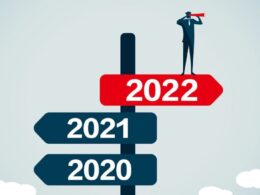Thomas H. Davenport argues healthcare organizations will need to get more digital …
… or cede the business of health to other industries and types of organizations.
The Yuan
By Thomas H. Davenport
Feb 08, 2022
Image courtesy of and under license from Shutterstock.com
CAMBRIDGE, MASSACHUSETTS —
Banking is one of the most aggressively digital, data-focused, and analytics and AI-oriented industries in the world …
… and healthcare one of the least.
Many reasons might be advanced for this disparity, but they do not justify healthcare organizations continuing with their much less advanced status.
In this regard, healthcare organizations can and should move in the direction of banks in the future, and those that do so earlier will be more successful.
To do otherwise is to invite competitors from outside the healthcare industry to enter it with more digital and data-centric business models.
Several aspects of digitization and intelligence are described below, with details as to how banks and healthcare organizations have addressed them.
Banks have multiple channels for transacting business.
Unlike many healthcare providers, banks have already seen their future, which is to become increasingly digital and decreasingly facilities-based.
There are still bank branches and headquarters of buildings for specialized transactions and to house employees, but the core of the banking experience for many customers is already the online bank account, the bank website, the chatbot, and the mobile app.
Most channels and transactions are available 24/7. The industry has succeeded at creating anytime, anyplace any channel banking that allows customers to go about their financial business with convenience and flexibility.
Healthcare is still heavily focused on hospitals and doctors’ offices, although the industry has made some progress.
Pharmacies and grocery stores increasingly have clinics in the United States, and many providers have online portals.
In China and Southeast Asia, digital healthcare applications (apps) have made strong inroads, but less so in other regions.
Home healthcare around the world is increasingly facilitated by connected monitoring devices and wearables, but these are not generally well-integrated.
Given so many devices and points of care, provider institutions will need to integrate and analyze all of the data that is streaming from and about the patient.
Instead of being facility-driven, care will need to be data-driven, continuous, predictive, and prescriptive.
Instead of being facility-driven, care will need to be data-driven, continuous, predictive, and prescriptive.
Banking institutions move data around easily.
There are many different currencies and financial instruments around the world, but that hasn’t stopped banks from moving vast amounts of money and monetary information across financial institutions.
We can wire money from an Alabama bank to one in Abu Dhabi in a few minutes — at low cost and with little risk of fraud.
Some countries, such as the United Kingdom, have instituted ‘open banking‘ systems that let customers aggregate all their assets and transactions across banks in one digital place.
Some other countries haven’t embraced that yet, but third-party vendors do offer financial and data aggregation.
Electronic Healthcare Systems
Healthcare data is not nearly as fluid across organizations.
Most data portals only contain health records from one provider.
Some nationalized healthcare systems, like those in Australia and Denmark, have a common electronic health record system (EHRs), but other national systems, like those in the UK and Canada, do not have a single system or an interoperable one.
Even some countries that do have national EHRs have experienced slow adoption by institutions and citizens.
And, unlike in banking, there is no means of moving healthcare data across international boundaries.
Some claim that healthcare data privacy regulation prevents the easy transfer of healthcare data, but then information about finances and money movement also requires high levels of privacy and security.
Private tech firms have not yet succeeded in integrating healthcare data.
Companies that are heavily focused on data capture, storage, and analysis have already signaled their interest in managing patient data.
Google, Microsoft, Amazon, and Meta — formerly Facebook — have made forays into healthcare data collection and analysis, mostly unsuccessfully.
Even the companies with failed initiatives, however — e.g., Microsoft’s HealthVault — are undeterred and continue to pursue healthcare capabilities.
In 2020 Microsoft paid US$16 billion to acquire Nuance, a leading provider of healthcare natural language processing software.
Many banks and financial institutions offer digital financial advice.
‘Robo-advice,’ or personalized advice using analytics or AI, is fairly pervasive in financial services firms now.
Banks were typically a bit behind investment firms in offering it, but many banks offer it as well.
Even the more transactional apps offer ‘safe to spend’ amounts or tell customers whether they are likely to achieve savings goals.
More complex robo-advisor systems, such as at Morgan Stanley, offer ‘next best action’ investment options.
Most healthcare systems, alas, do not offer digital health advice.
There are conspicuous exceptions, such as the highly popular Ping An Good Doctor system in China, and other ‘Internet hospital‘ systems there.
In the UK, the NHS Digital service is still nascent; some startups like Babylon are prospering.
In the US, both startups and health insurance companies are offering digital health and/or wellness advice, but most of it is not personalized, and the number of subscribers is small.
In short, healthcare is well behind banking in this regard in most countries.
Many banks have also embraced AI-based customer service.
Most large banks now have some sort of natural language ‘bot’ to check balances, see if a paycheck has arrived, or move money around.
In the US, Bank of America’s Erica chatbot has completed hundreds of millions of transactions, and makes simple cash management recommendations to customers.
In China, vendors like Shanghai-based Xiao-i and AISpeech in eastern Jiangsu province power the interactions of millions of customers with their banks.
Embracing AI in Healthcare
A few healthcare providers have experimented with chatbots, but their adoption falls well short of the banking industry.
Their use could support a variety of inbound and outbound healthcare transactions, including making appointments, calling for test results, and checking on reimbursements.
They could relieve staff of many tedious interactions.
Even though healthcare hasn’t yet fully embraced AI for medical advice or patient services, it’s easy to see how important it will be in the future.
Hospitals, clinics, and physicians’ offices will still be necessary for medical procedures, but the core of the patient’s medical experience will shift toward AI-enabled online portals and mobile apps.
The hospital or primary care provider will become the primary data gatherer and analyzer for a variety of medical devices and sensors, both in the home and wearables on (and in) patients’ bodies.
The hospital or primary care provider will become the primary data gatherer and analyzer for a variety of medical devices and sensors, both in the home and wearables on (and in) patients’ bodies.
AI will make sense of all the data, make ongoing healthcare recommendations, and let the patient know when he or she needs to be seen by a clinician.
AI will drive precision medicine, in which every drug and treatment approach is tailored to a patient’s genome, proteome, biome, and living/social/economic situation.
If traditional healthcare providers are to survive, they need to be more like banks.
Otherwise, they risk playing no role in our digital and intelligent future.
Electronic medical record systems are now pervasive in providers across many countries, but most are sorely lacking in integration across organizations, in the ability to make data-driven recommendations, or in predicting impending healthcare problems to patients.
Individual providers don’t share their data with other providers, don’t gather data from wearables or home healthcare devices, and rarely attempt to create a holistic view of patients’ health.
Banks and leading firms in other industries are much more capable in this regard.
Healthcare organizations will need to either get smarter and get more digital, or cede the business of health to other industries and types of organizations.
Originally published at https://www.the-yuan.com.












